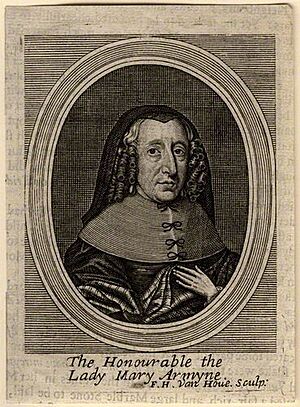Mary Armine facts for kids
Lady Mary Armine (also spelled Airmine or Armyne) was a smart and kind English lady who lived a long time ago. She was known for her learning and for using her wealth to help many people. She was born Mary Talbot, and her father, Henry Talbot, was the son of a powerful nobleman, the 6th Earl of Shrewsbury.
Mary was married twice. Her first husband was Thomas Holcroft. Later, she married Sir William Armyne, a baronet from Osgodby, Lincolnshire.
Contents
A Smart and Active Life
Lady Mary was very intelligent and had many skills. She knew how to speak French and Latin very well. She also loved to read a lot, especially about history and religious topics.
People admired her for her excellent business skills. Even when she was older, she remained very active and was known for her beauty. Many people who knew her often talked about how impressive she was throughout her life.
Helping Others with Her Wealth
Lady Mary Armine used her money to support many good causes. She was a true helper and benefactor.
Supporting Religious Leaders
In 1662, a time when many religious leaders lost their jobs, Lady Mary gave a large sum of money, £500, to help their families. She often helped religious leaders who were struggling financially. They could always count on her for support.
Helping Native American Communities
Lady Mary also cared about people who were teaching Christianity to Native American groups in North America. She showed a strong interest in their work and helped them in practical ways.
Founding Hospitals and Charities
At home in England, Lady Mary founded three hospitals to care for people. One of these hospitals was located at Barton Grange in Yorkshire. When she passed away, she left money in her will to be used for charity for almost a hundred years after her death. This shows how much she wanted to keep helping people even after she was gone.
Her Legacy
Lady Mary Armine died on March 6, 1676, when she was over eighty years old. A famous artist named Cornelius Jansen painted her portrait, which can still be seen today at Welbeck. After she died, a special poem was written about her by a well-known writer, John Sheffield. The poem honored her life and her generous spirit.
Images for kids



